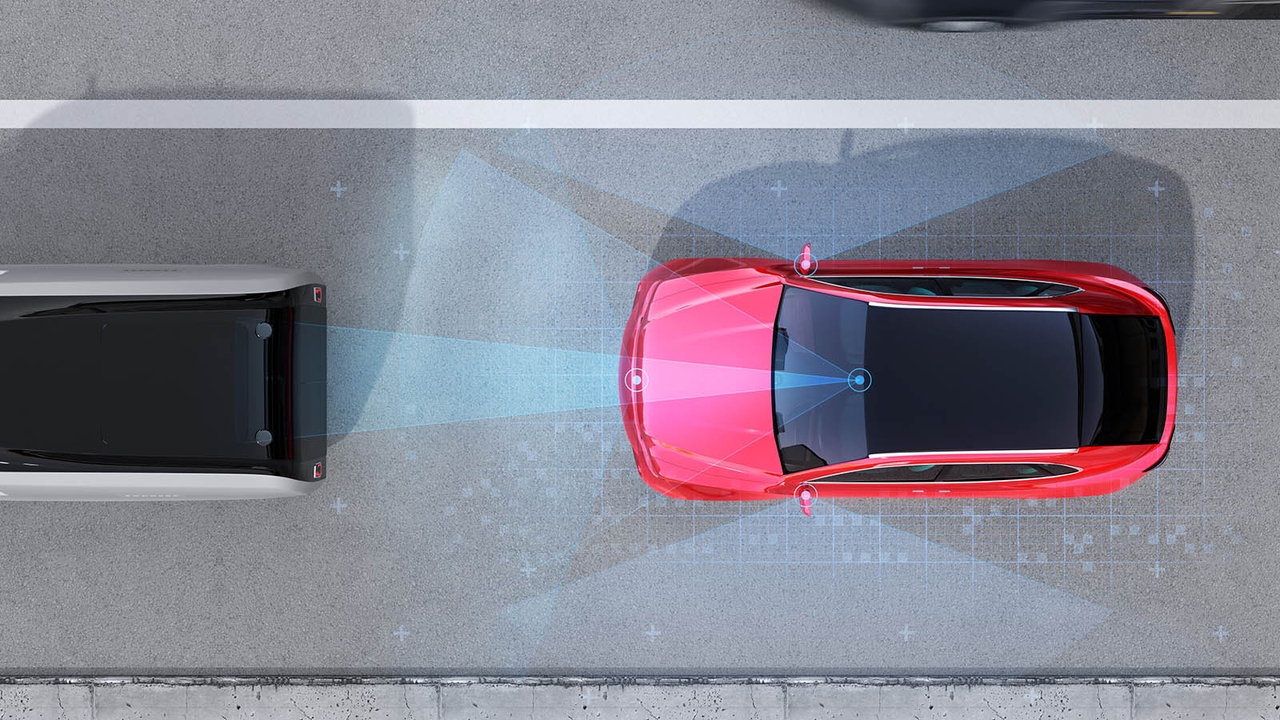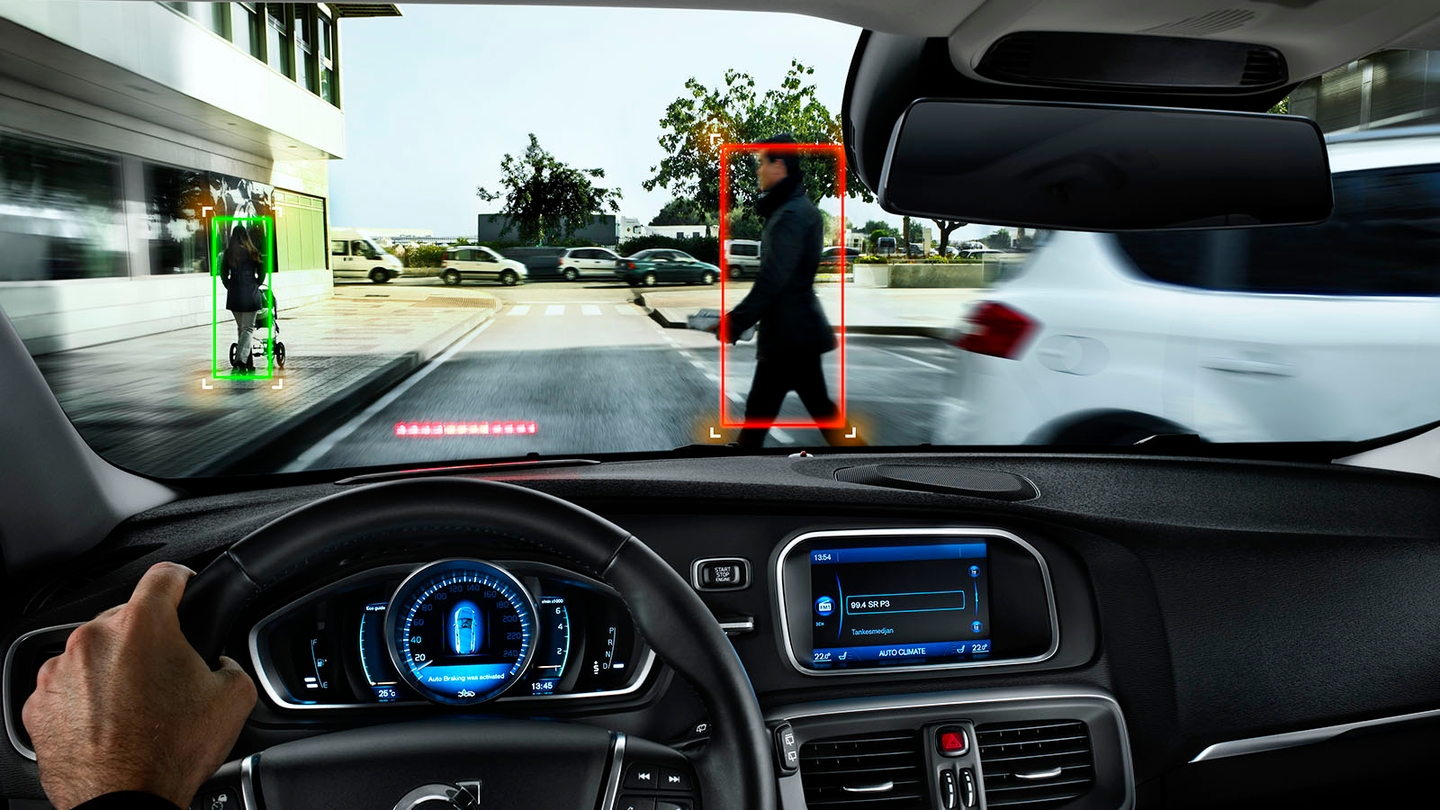Automatic emergency braking does more-or-less what it says on the tin.
In an emergency, it'll hit the brakes – automatically. Specifically, if the system thinks you're about to drive into something in front of you. You might also hear it called autonomous emergency braking.
How does automatic emergency braking work?

Most modern cars include a forward-facing radar sensor. That's the little blank plastic plate you might've spotted on the front grille, or hidden in a little dome in the bumper. Some cars, such as Teslas and Subarus, swap the radar out for video cameras and clever image-processing software. Whichever system your car uses, these sensors spot and track obstacles that might cross into your path.
Usually, time-permitting, the car will flash up an audio and visual warning if it thinks there's a risk you're going to crash. If the obstacle appears too quickly, or the driver fails to react to the warning, the system will automatically apply hard braking to either avoid a crash or reduce its severity.
Does my car have automatic emergency braking?

For obvious reasons, it's not a good idea to go out and see if your car tries to stop itself before being driven into obstacles. An obvious giveaway, however, will be if there's some kind of radar panel or dome on the front of your car, or a pair of cameras in the rear-view mirror housing.
Adaptive cruise control uses exactly the same sensor systems as automatic emergency braking. As a result, cars fitted with adaptive cruise control invariably also include automatic emergency braking because all the necessary hardware is already there.
Automatic emergency braking was already being voluntarily fitted throughout the 2010s by many brands. From May 2022, however, it became mandatory on all new cars in Europe and the UK, and is expected to become a requirement in North America in 2029.
Is automatic emergency braking different to forward collision warning?

Yes. If the car detects that a crash is likely, the forward collision warning system will kick in first. As the name suggests, this is simply a warning that a collision might occur, hoping to alert the driver to take action before any more drastic intervention is needed.
The difference is that automatic emergency braking will actually step in if it thinks a crash is going to happen. If the driver doesn't react to the forward collision warning, or the obstacle appears too quickly for a warning to be effective, automatic emergency braking will hit the brakes hard to avoid a collision or lessen the impact.
Should I use automatic emergency braking?

Yes. Just like seatbelts, airbags and ABS, automatic emergency braking provides another layer of defence when you're out on the road.
We've all occasionally suffered from brief lapses of concentration. Usually, these result in nothing more than a close call, but there's always a risk that a sudden obstacle could appear just as your mind wanders from watching the road.
These edge cases can easily result in nasty crashes and are where automatic emergency braking proves its value. Not only does it keep an eye out should you make a split-second mistake, it's also programmed to brake as hard as possible – something human drivers have been shown to struggle with, even in emergencies.
Which cars come with automatic emergency braking?

Almost all current models from all major manufacturers now include automatic emergency braking. This is partially due to customer demand and partially thanks to the system becoming mandated in new cars in Europe and the UK from May 2022.
Different brands often have different names for the system, although they all work the same way. Tesla, for example, calls it Collision Avoidance Assist, while Ford's named it Pre-Collision Assist with Automatic Emergency Braking.
Pros and cons of automatic emergency braking
Pros
- Constant extra layer of safety on the road
- Brakes as hard as possible if it needs to
- Usually bundled with other features such as adaptive cruise control
Cons
- May overreact or brake when not necessary, though this is extremely rare
- Some older systems can't detect pedestrians or cyclists
- Some drivers don't like being 'nannied'
How to turn automatic emergency braking off

We'd generally recommend you always leave your automatic emergency braking system turned on. The system only intervenes when it's absolutely necessary, and it could save you from a potentially dangerous and expensive mistake.
If, however, you decide you want to turn the system off, you can usually access the option through your car's infotainment system. Generally, the option to enable or disable the automatic emergency braking will be found in the vehicle settings menu, possibly under a safety systems submenu. Many modern cars will reactivate the system automatically every time you start the car, so you'll have to repeat this process every time you want to turn the system off. Again, we'd just recommend leaving it on for simplicity and safety.
Save money on your next car
Motorpoint has thousands of nearly new and used cars available to buy or finance, including many with automatic emergency braking and other advanced safety tech. Learn more about the systems protecting you on the road with our guides to lane-keep assist and adaptive cruise control.


































